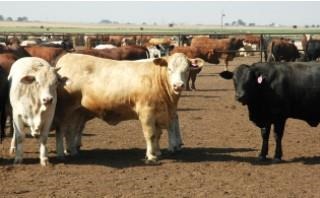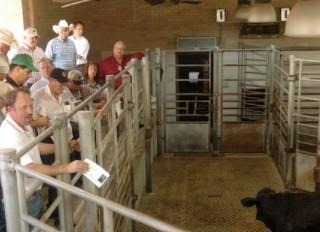A recent report by the Agricultural and Food and Policy Center, AFPC, at Texas A&M University provides an assessment of the proposed Cattle Price Discovery and Transparency Act of 2021, known as Senate Bill 3229, and its potential impact on segments of the beef and cattle supply chain.

A recent Agricultural and Food Policy Center report assesses the potential impact of the Cattle Price Discovery and Transparency Act of 2021 on aspects of the cattle and beef supply chain. (Texas A&M AgriLife photo by Kay Ledbetter)
The lead author for the report was Texas A&M AgriLife Extension Service economist Justin Benavidez, Ph.D., Texas A&M AgriLife Research and Extension Center in Amarillo. Collaborators included AFPC co-directors Bart Fischer, Ph.D., and Joe Outlaw, Ph.D., as well as AgriLife Extension economist David Anderson, Ph.D., all of Bryan-College Station.
“This report is comprised of two parts,” Fischer said. “The first is an analysis of the impact of the bill on negotiated trade volume. The second is a qualitative, economics-based summary of the bill’s expected effects.”
The report presents the expected effects in a matrix format, highlighting the anticipated directional impact of each portion of the bill on a set of stakeholder groups and market outcomes, including cattle and beef prices, market transparency, price discovery and data confidentiality.
Background on report
In November, a bipartisan group of U.S. senators announced a compromise cattle market proposal that was introduced as the Cattle Price Discovery and Transparency Act of 2021.
Sen. John Boozman, R-Ark., ranking member, Senate Committee on Agriculture, Nutrition and Forestry, requested that AFPC evaluate the potential impact the bill may have on various segments of the beef and cattle supply chain.
“The report builds on work published by AFPC in October 2021 at the request of the bipartisan leadership of the House Committee on Agriculture in the 116th Congress,” Fischer said.
What would Senate Bill 3229 do?

Buyers at a cattle auction. (Texas A&M AgriLife photo)
“The bill proposes to establish a regional mandatory minimum threshold for the percentage of cattle purchased under negotiated grid or negotiated pricing terms,” Benavidez said. “It also proposes the establishment of a cattle contract library and to expand reporting requirements for cattle pricing and slaughter.”
The bill establishes regional mandatory minimum thresholds of negotiated cash and negotiated grid trades based on a region’s 18-month average trade. The National Cattleman’s Beef Association has voiced concern with the negotiated minimums portion of the bill, as has the American Farm Bureau Federation.
To determine if the minimum and maximum bounds of the bill as proposed impose an economic cost to the cattle market, the authors established an unrestricted forecast of negotiated trade for various U.S. cattle-producing regions – Texas-Oklahoma, New Mexico, Kansas, Nebraska and Iowa-Minnesota.
In each region, they modeled expected negotiated trade as a function of:
• The trend in negotiated trade.
• Whether the cattle cycle year saw an increase or decrease in herd size.
• Seasonality of historic negotiated trade.
• The previous week’s negotiated trade volume.
• Total weekly fed cattle trade.
The criteria also included a dummy variable accounting for the introduction of the industry-led “75% Plan.”
“The difference in the expected amount of unrestricted negotiated trade and the amount of negotiated trade compelled by Senate Bill 3229 provides a measure of the cost of the bill’s negotiated trade provisions,” Benavidez explained.
The report contains figures showing the expected unrestricted negotiated trade plotted against the negotiated trade minimums compelled by the bill through December 2026, a five-year outlook.
The authors also addressed whether changes in negotiated volume would have a cost.
“Typically, a move away from alternative marketing arrangements or AMA’s results in lost efficiency,” Anderson said. “This efficiency loss translates directly into increasing the transaction cost of buying and selling cattle.”
Anderson said industry research also shows packers that operate with AMAs tend to have lower marketing costs.
“Reliability of supply is a critical component in operating a large packing plant, and industry research has shown plants with higher AMA volumes have more stable average monthly volumes,” he said. “And the increased costs from a mandated reduction in AMA use would be shouldered by the cattle feeding sector.”
Benavidez noted the report also shows the region that includes Texas would see the greatest negative impact from the imposition of mandatory trade minimums.
Expected effects of the bill
The report also provides a matrix of the expected effects of the bill by its three primary segments:
- Negotiated Trade Mandate – Mandated levels of negotiated trade are expected to have negative effects on short-term cattle and calf prices.

The report notes that while the bill would increase price discovery, it would mean lower prices to cattle producers and higher prices to beef consumers. (Stock photo)
“Negotiated trade mandates do provide additional price discovery and market transparency, but more price discovery does not mean that cattle prices will be higher,” Benavidez said. “The mandate will result in lower short-term fed cattle prices due to the increase in the costs of the feeder-packer cattle sale transaction.”
Benavidez said the bill does increase price discovery, but at the cost of lower prices to cattle producers and higher prices to beef consumers.
- Contract Library – The effects of the contract library would be exclusively felt in terms of market transparency in that such a library would increase market transparency.
- Expanded Reporting Requirements – Reporting requirement expansion would impact two areas, transparency and discovery, and would likely increase both.
“In overall terms of the bill’s impact on various segments of the beef and cattle supply chain, the bottom line is that there would be tradeoffs,” Fischer said. “While it may be able to achieve greater price discovery and market transparency, forcing the movement away from AMAs via regional mandatory minimums for negotiated purchases will result in lower cattle prices and higher wholesale and retail beef prices.”
Source : tamu.edu